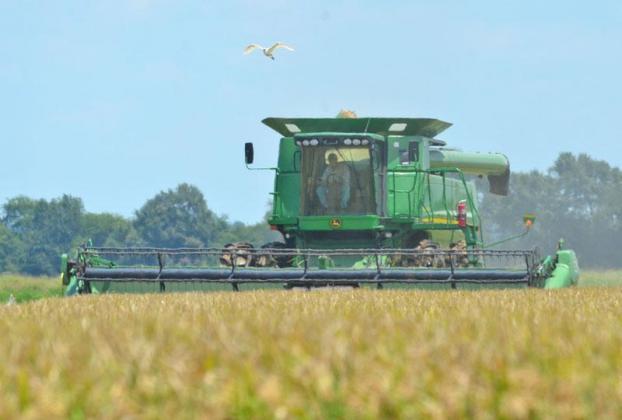
Bruce Schultz
The 2017 rice harvest is wrapping up in south Louisiana with overall results considered fair because of unfavorable weather, but an approaching tropical storm could complicate getting the remaining crop out of the fields.
Steve Linscombe, director of the LSU AgCenter H. Rouse Caffey Rice Research Station, said 2017 will not rank among the top yielding years. “We’re going to have an OK crop, but certainly not near a record yield,” he said.
Results vary widely. “It’s as much variation as I’ve seen in quite a while,” Linscombe said. “This has been one of the more difficult years for me to make an estimate on our statewide yield.”
At the start of harvest, yields ranged from good to very poor. “It’s been that way throughout the season with a gradual reduction,” he said
But Linscombe said he’s not surprised that this year’s crop has been subpar. Half of the days in June and July had measurable rain, and the cloud cover interfered with the sun’s radiant energy needed for photosynthesis.
Linscombe referred to an old observation that the best rice crops are made in years when pumping large amounts of water is required to maintain a flood to compensate for low rainfall.
Added to the cloudy weather was wind from Tropical Storm Cindy, which hit Louisiana in June just as many rice plants were flowering for pollination, he said. The winds damaged the panicles, resulting in numerous blank seed heads, resulting in lowered yields.
Milling quality has been good, probably because day and night temperatures were moderate, with many days not exceeding 90 degrees. Excessively hot nights usually result in grains with more chalk, Linscombe said.
On a positive note, the ratoon, or second, crop is off to a good start. Harvest began earlier than usual because of earlier-planted rice, and that should help the second-crop fields.
James Meaux, AgCenter extension agent in Calcasieu Parish, said about 80 percent of the rice there has been harvested. Some farmers in the Vinton area have not been able to harvest, and Hurricane Harvey could cause even more delay.
“They’re probably really getting nervous now. Hopefully it’s not going to be as bad as they say,” Meaux said.
Some fields have been ready for more than a week, but they keep getting rainfall. “We just haven’t had a lot of consecutive dry days,” he said.
One farmer hasn’t been able to apply fertilizer on a field for a second crop because runways are too wet for airplanes.
Meaux said yields have been in the high 30-barrel range to the mid-40s.
Results from the first fields harvested in northeast Louisiana are more encouraging. AgCenter extension rice specialist Dustin Harrell said the harvest recently began in north Louisiana.
“Excellent yields so far,” Harrell said. “The crop has just been tremendous up there.”
Some fields are producing in excess of 200 bushels (56 barrels), and one farmer had 215 bushels (60 barrels) per acre.
The difference in the north is the result of weather’s influence on the two areas of the state. North Louisiana had rain, but not when rice plants were flowering, and with drier conditions, sheath blight disease in north Louisiana rice has not been bad, Harrell aid.
Early yields in southwest Louisiana varied considerably. “We had some really good yields and very poor yields,” he said.
With the boost from the north Louisiana harvest, the overall crop from Louisiana’s 395,000 acres will be about average, Harrell said.
Keith Collins, AgCenter extension agent in Richland Parish, said growing conditions have been good in northeast Louisiana.
“Overall, we’ve had a good year for it,” Collins said. Adequate rainfall has reduced pumping costs.
Todd Fontenot, AgCenter extension agent in Evangeline Parish, estimated that 75-80 percent of the crop there has been harvested.
“We’re still fighting the rains,” Fontenot said. “The rice being harvested now should have been harvested a week ago.”
Disease has affected this year’s crop. “There’s a lot of disease pressure, a lot of sheath blight, and that has hurt some yields,” he said.
The parish average is probably in the mid-40-barrel range for both conventional and Clearfield varieties. Hybrids have varied considerably, with some yields exceeding 60 barrels per acre, he said.
More farmers are starting or increasing crawfish operations, and that has reduced the number of fields that will be in second-crop rice.
Andrew Granger, AgCenter extension agent in Vermilion Parish, estimated harvest completion at 80-85 percent there.
Yields were fair-to-good early in the harvest at 40-50 barrels an acre, but that has decreased. “Lately, it’s been the upper 30s or lower 40s,” Granger said.
Farmers had to deal with heavy disease pressure. “It’s as bad as I’ve seen,” he said.
Sheath blight was the worst culprit, he said. Some fields had Cercospora early in the season, but they were treated. “Some of that yielded as well as anything,” Granger said.
Jeremy Hebert, AgCenter extension agent in Acadia Parish, said a large portion of the crop there is harvested.
“We are probably looking at 80-85 percent finished,” Hebert said. “Overall, the rice crop is good, not excellent and not poor, but a pretty good rice crop.”
A slight price increase probably encouraged more farmers to grow a second crop. “People were excited to see a little jump” in price, he said.
Many farmers were not able to work the stubble for a second crop because fields were too muddy.
Farmers didn’t have to use much insecticide, but disease resulted in a larger amount of fungicide use. “There was a lot of sheath blight and some blast,” Hebert said.
Frances Guidry, AgCenter extension agent in Jefferson Davis Parish, said sheath blight has been a problem because of excessive rain.
Yields there are not outstanding. “Everything has been average to low,” she said.
